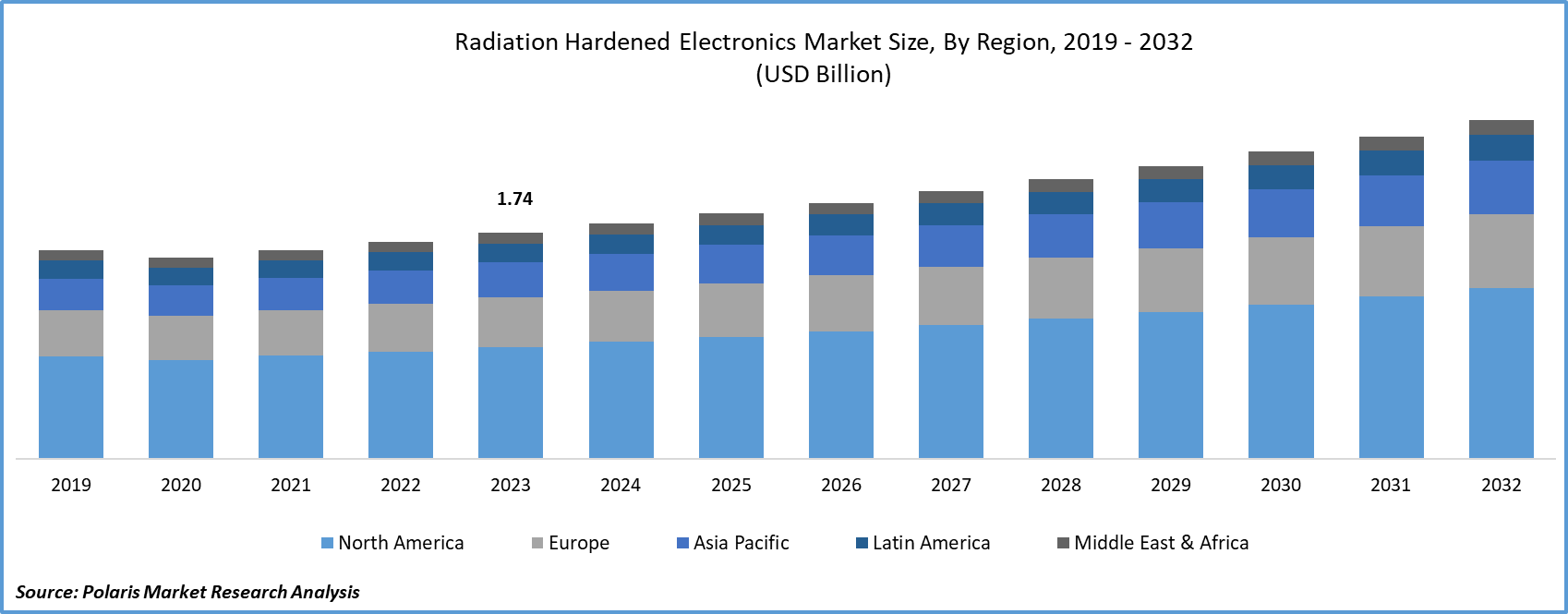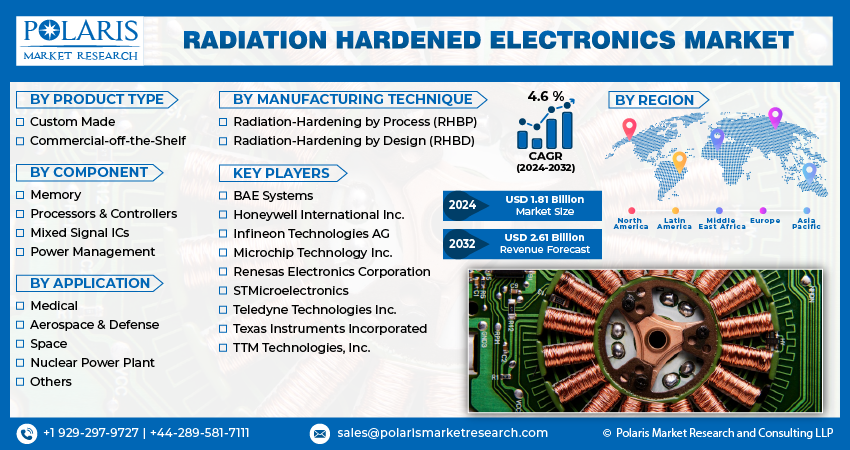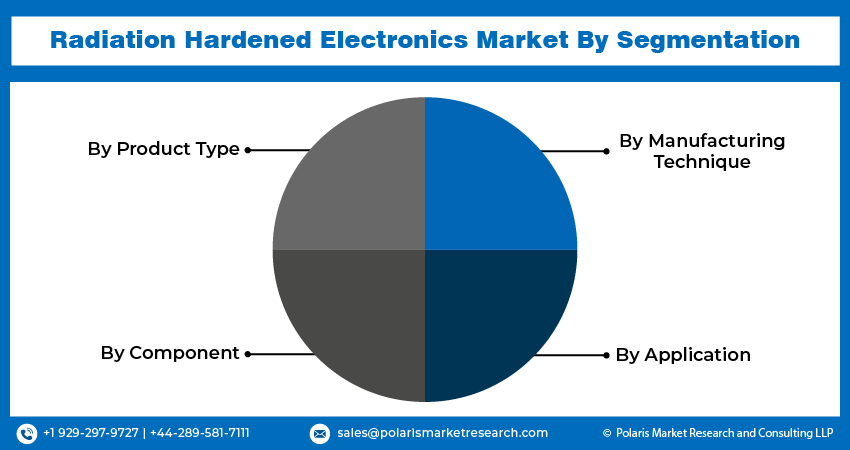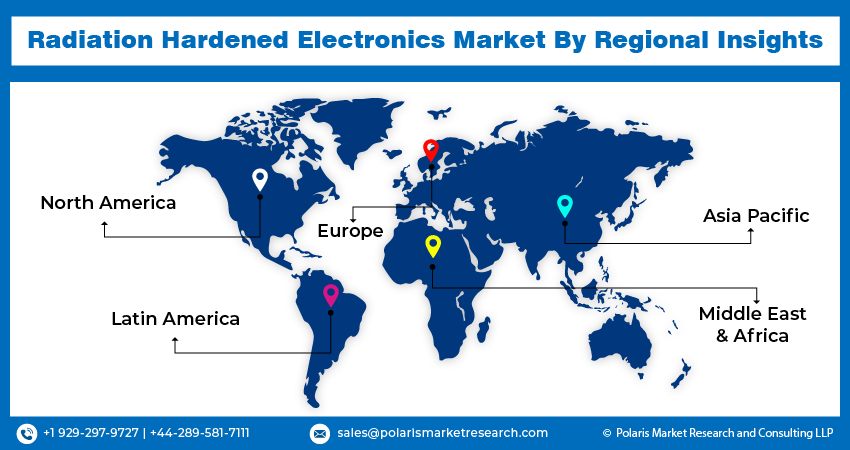
Radiation Hardened Electronics Market Share, Size, Trends, Industry Analysis Report, By Product Type (Custom Made, Commercial-off-the-Shelf (COTS)); By Component; By Manufacturing Technique; By Application; By Region; Segment Forecast, 2024- 2032
- Published Date:Mar-2024
- Pages: 116
- Format: PDF
- Report ID: PM4718
- Base Year: 2023
- Historical Data: 2019 – 2022
Report Outlook
Global radiation hardened electronics market size was valued at USD 1.74 billion in 2023. The market is anticipated to grow from USD 1.81 billion in 2024 to USD 2.61 billion by 2032, exhibiting a CAGR of 4.6% during the forecast period.
Radiation Hardened Electronics Market Overview
The radiation-hardened electronics market is expected to register a significant share of revenues owing to the rising application of communication satellites and the soaring frequency of modern smart surveillance and reconnaissance activities. In addition to this, an increasing number of commercial space programs and the use of e-radiation exposure systems for the detection of space radiation are expected to fuel the industry share. Additionally, the current space exploration and satellite communications tendencies for respective hardware have created an enlarged requirement for radiation-hardened electronic devices that can send and receive signals from satellites.

To Understand More About this Research: Request a Free Sample Report
The noted radiation-hardened electronics market growth is mainly driven by the increased utilization of electronic products that are capable of working efficiently in a high-radiation environment that is recreated while traveling through space or nuclear reactors. Additionally, a popular push is compounded by the fact that AI is ingraining itself faster, even in the smallest electronics, which opens up the vista for greater innovation.
The use of electronics, specially hardened to withstand radiation, as well as the shielding of electronic components, have been proven as core key areas driving the radiation-hardened electronics market global aggregate. By the way, radiation-hardened Integrated Circuits (ICs) being in higher demand for satellite protection from high rock radiation and immediate radiation exposure to ensure that communication is not interrupted by any means, becomes the most viable solution. Additionally, the strengthening defense intelligence, surveillance, and reconnaissance operations, triggered by on-the-rise geopolitical strife among the developed countries, will eventually be crucial in bringing about the radiation-hardened electronics market's revenue acceleration.
In the end, space technology applications' growing demand, technology progress, and armed forces equipment improvement are the driving forces of the radiation-hardened electronics market, among which four areas converge. The market displays a healthy growth trajectory in response to the need for communication, the increased use of satellites, and the transmission of signals in severe radiation environments that are gradually becoming of interest for their use in mission-critical applications.

Radiation-Hardened Electronics Market Dynamics
Market Drivers
Rising operations in surveillance, intelligence, and reconnaissance (ISR) bolstering the growth of the Radiation Hardened Electronics market share.
As global geopolitical tensions rise, there is an increased focus on bolstering defense capabilities and enhancing situational awareness. Intelligence agencies and defense organizations are investing extensively in radiation-hardened electronics to ensure the reliability and resilience of electronic systems deployed in critical ISR applications. These specialized electronic components are designed to withstand the harsh conditions of space and high-radiation environments, providing a crucial technological foundation for satellites, reconnaissance aircraft, and other ISR platforms. The growing need for secure and dependable communication, data processing, and sensor functionalities in ISR operations is a key factor propelling the radiation-hardened electronics market forward.
Moreover, the continuous advancements in ISR technologies, including the integration of Artificial Intelligence (AI) and sophisticated sensors, further contribute to the demand for radiation-hardened electronics. As ISR platforms become more technologically advanced and complex, there is an increasing reliance on electronic systems capable of enduring the rigors of space and maintaining operational integrity in the face of potential radiation-induced disruptions. The radiation-hardened electronics market's growth is thus intricately linked to the evolving landscape of intelligence and defense capabilities, where radiation-hardened electronics play a pivotal role in ensuring the reliability and effectiveness of ISR missions.
Market Restraints
Challenges associated with establishing an authentic testing environment likely to hamper the growth of the market.
The development of a testing environment capable of accurately representing conditions experienced in space, during a nuclear war, or in a defense environment. Actual environments expose electronic systems to a intricate blend of radiation types, energies, and intensities. Replicating this intricate mix precisely within a testing laboratory proves to be challenging and often necessitates the utilization of multiple sources and techniques. The difficulty lies in achieving a comprehensive simulation that mirrors the complex radiation scenarios encountered in real-world settings, posing a constraint on the precision and thoroughness of testing for these specialized components.
Report Segmentation
The market is primarily segmented based on product type, component, manufacturing technique, application, and region
|
By Product Type |
By Component |
By Manufacturing Technique |
By Application |
By Region |
|
|
|
|
|
To Understand the Scope of this Report: Speak to Analyst
Radiation Hardened Electronics Market Segmental Analysis
By Application Analysis
- The aerospace and defense segment accounted for the largest radiation-hardened electronics market share in 2023. This dominance is primarily attributed to the substantial investments made by governments globally. The aerospace and defense sectors are consistently engaged in operations within radiation-rich environments, encompassing space, high altitudes, and nuclear settings. Given the prevalent radiation in these environments, there is a heightened risk of electronic system disruption or damage, potentially jeopardizing critical missions. As a result, the robust demand for radiation-hardened electronic solutions within the aerospace and defense industry is a direct response to the imperative need for resilient and reliable electronic systems in these challenging operational contexts.
By Manufacturing Technique Analysis
- The Radiation Hardened By Process (RHBP) technique is expected to witness the highest CAGR during the forecast period. It employs the integrated circuit (I.C.) fabrication process along with specific modifications to enhance the resilience of electronic components. In addressing the challenges posed by radiation, RHBP focuses on altering the transistor bodies to make them less susceptible to the degrading effects of radiation exposure. By doing so, the technique aims to fortify electronic components, ensuring their reliability and performance in radiation-intensive environments, such as those encountered in space or defense applications.
- However, the widespread adoption of RHBP is constrained by the fact that its implementation requires modifications to the I.C. fabrication process. This modification is a comprehensive endeavor, demanding significant adjustments to the manufacturing process to accommodate the production of radiation-hardened components on a large scale. Given the extensive changes involved, this process becomes both time-consuming and expensive, limiting its applicability in scenarios where there is not a substantial demand for radiation-hardened components. The inherent challenges in modifying I.C. fabrication for extensive volume production make the RHBP technique more viable in specialized applications where the specific hardening against radiation is deemed crucial, outweighing the associated costs and complexities.

Radiation Hardened Electronics Market Regional Insights
The North American region dominated the largest market share in 2023
In 2023, the North American region dominated the largest market share. The focus on space and nuclear programs, in addition to the government investments in space electronics radiation hardened for space missions, also supplement the further growth of the market revenue. Additionally, the expansion in the production of radiation-tolerant materials and the growing environmental concerns connected with the vast amounts of radioactive discharge from nuclear weapon testing are supporting the increase of market revenue. The participation of important entities, such as BAE Systems plc., will ensure that the production is not only improved but also a number of innovative products are developed. BAE Systems plc. Focuses on building reliable and radiation-resistant devices to power both civil, commercial and national security space projects. The enterprise has been focusing on the fabrication and employment of sophisticated radiation-hardened ASICs used mostly in the strategic areas of defense and space.
The U.S. Department of Defense (DoD), among other measures, is concentrating on boosting production of radiation-hardened and crucial microelectronic components through legislative efforts and specifically the modernization of satellites and nuclear plants. Along with the efforts of the U.S. Government to enhance the domestic production of strategic radiation-hardened microelectronics components to avoid imports and promote self-reliance, this is done simultaneously.

Competitive Landscape
The competitive landscape of the Radiation Hardened Electronics (RHE) market is marked by a combination of established aerospace and defense industry leaders, innovative technology companies, and specialized manufacturers. This market niche focuses on delivering electronic components and systems capable of withstanding the harsh conditions of space, high-altitude flights, and nuclear environments, making it crucial for space exploration, satellite communication, and defense applications.
Some of the major players operating in the global market include:
- BAE Systems
- Honeywell International Inc.
- Infineon Technologies AG
- Microchip Technology Inc.
- Renesas Electronics Corporation
- STMicroelectronics
- Teledyne Technologies Inc.
- Texas Instruments Incorporated
- TTM Technologies, Inc.
Recent Developments
- In November 2023, Infineon Technologies AG extended its line of asynchronous static random-access memory (SRAM) chips of radiation-hardened tailored for space applications. Employing RADSTOP technology, these chips incorporate proprietary techniques to bolster radiation hardness, guaranteeing elevated reliability and performance in challenging environments.
Report Coverage
The radiation hardened electronics market report emphasizes key regions across the globe to provide a better understanding of the product to the users. Also, the report provides market insights into recent developments and trends and analyzes the technologies that are gaining traction around the globe. Furthermore, the report covers an in-depth qualitative analysis pertaining to various paradigm shifts associated with the transformation of these solutions.
The report provides a detailed analysis of the market while focusing on various key aspects such as competitive product type, component, manufacturing technique, application and futuristic growth opportunities.
Radiation Hardened Electronics Market Report Scope
|
Report Attributes |
Details |
|
Market size value in 2024 |
USD 1.81 billion |
|
Revenue Forecast in 2032 |
USD 2.61 billion |
|
CAGR |
4.6 % from 2024 – 2032 |
|
Base year |
2023 |
|
Historical data |
2019 – 2022 |
|
Forecast period |
2024 – 2032 |
|
Quantitative units |
Revenue in USD billion and CAGR from 2024 to 2032 |
|
Segments Covered |
By Product Type, By Component, By Manufacturing Technique, By Application, By Region |
|
Regional scope |
North America, Europe, Asia Pacific, Latin America; Middle East & Africa |
|
Customization |
Report customization as per your requirements with respect to countries, regions, and segmentation. |
FAQ's
key companies in Radiation Hardened Electronics Market are AMD, BAE Systems, Honeywell International Inc., Microchip Technology Inc., Renesas Electronics Corporation
Radiation hardened electronics market exhibiting a CAGR of 4.6% during the forecast period.
The Radiation Hardened Electronics Market report covering key segments are product type, component, manufacturing technique, application, and region
key driving factors in Radiation Hardened Electronics Market are rising operations in surveillance, intelligence, and reconnaissance (ISR)
The global Radiation Hardened Electronics market size is expected to reach USD 2.61 billion by 2032
